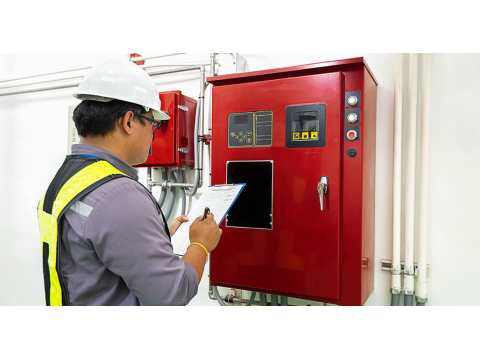HOW TO INSPECT YOUR FIRE ALARM SYSTEM
SENSORS
INSPECTION REPORT
ESSENTIAL TESTING METHODS
Inspecting your fire alarm system ensures it functions as intended, safeguarding your property and people in case of a fire. Fire alarm inspections are conducted in two main scenarios:
- During System Commissioning: Ensuring functionality before operation begins.
- During Routine Maintenance: Periodic checks to detect issues and maintain reliability.
FIRE ALARM SYSTEM COMPONENTS UNDER INSPECTION
Fire alarms manage several critical systems:
- Notification systems.
- Automatic fire suppression systems.
- Smoke extraction systems.
- Other integrated engineering systems.
Testing must follow specific protocols to avoid costly errors, especially with fire suppression systems. Missteps during tests may lead to:
- Damage from fire suppression agents on items in the vicinity.
- Replacement or recharging of expensive modules like powder or aerosol suppressors.
To minimize risks, additional equipment should be disabled during tests. Systems like alarms and notifications can often be tested without such precautions but should be performed during off-hours or with prior notification to occupants.
HOW TO TEST FIRE ALARM SENSORS
Testing fire sensors often requires specialized equipment to simulate conditions accurately. Here are some practical methods:
Visual Inspection:
- Modern detectors usually feature a blinking LED to indicate functionality.
- Walk along the loop and verify the status of each sensor visually.
Limitation: A blinking light doesn't guarantee a functional alarm during an actual fire.
Test Button:
- Pressing the "test" button (if available) simulates sensor activation.
- This verifies the system's integrity but does not test smoke or heat sensors.
Test Port:
- Some sensors have a dedicated test port for simulating smoke.
- Insert a thin rod (1-2 mm) into the port to trigger the smoke detection mechanism.
Aerosol Simulation:
- Use a specialized aerosol that mimics smoke.
- Spray it directly into the sensor following the manufacturer's guidelines. This is the most accurate test for smoke detectors.
Note: For heat sensors, use a heat source like a hairdryer, avoiding direct flames or high temperatures that might damage the sensor casing.
- Line-type Smoke Detectors: Block the infrared or emitted beam with an opaque object to simulate a fault or fire.
- Flame Detectors: Test by exposing them to a flame with a matching radiation spectrum.
FIRE ALARM INSPECTION REPORT
Although there is no standardized form for a fire alarm inspection report, it should include the following:
- Owner and Contractor Information: Names and contact details of the building owner and inspection company.
- Inspection Date and Location: Record where and when the inspection was performed.
- System Details: List components of the system inspected.
- Inspection Results: Include detailed findings and test outcomes.
Example of Report Content:
Inspection Method:
- Simulated smoke detection in sensors IP 212-141M. System generated a "fire" signal and activated the alarm.
- Activated manual fire alarm IR 1, generating a "fire" signal and triggering the alarm.
- Simulated a circuit break, resulting in a "fault" signal.
- Disconnected main power. System switched to backup power, maintaining full functionality.
Additional Details:
- Simulating smoke in one sensor produced an "attention" signal.
- Simulating smoke in a second sensor escalated to a "fire" signal.
Such detailed documentation helps confirm the system's reliability and adherence to safety protocols.

